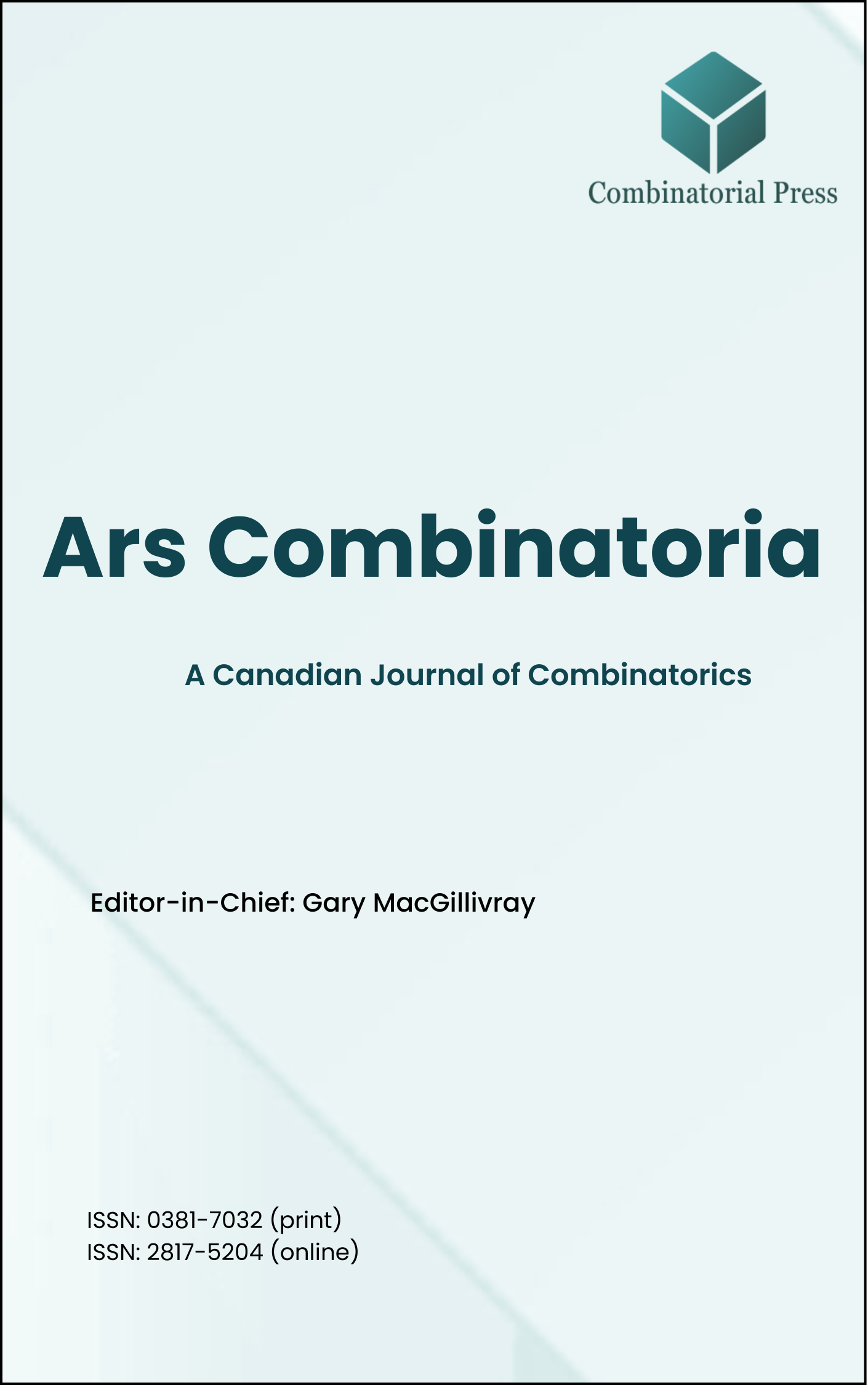
Ars Combinatoria
ISSN 0381-7032 (print), 2817-5204 (online)
Ars Combinatoria is the oldest Canadian Journal of Combinatorics, established in 1976. The journal is dedicated to advancing the field of combinatorial mathematics through the publication of high-quality research papers. From 2024 onward, it publishes four volumes per year in March, June, September and December. Ars Combinatoria has gained recognition and visibility in the academic community and is indexed in renowned databases such as MathSciNet, Zentralblatt, and Scopus. The Scope of the journal includes Graph theory, Design theory, Extremal combinatorics, Enumeration, Algebraic combinatorics, Combinatorial optimization, Ramsey theory, Automorphism groups, Coding theory, Finite geometries, Chemical graph theory but not limited.
Information Menu
- Research article
- Full Text
- Ars Combinatoria
- Volume 035
- Pages: 281-290
- Published: 30/06/1993
This paper gives two sufficient conditions for a \(2\)-connected graph to be pancyclic. The first one is that the degree sum of every pair of nonadjacent vertices should not be less than \(\frac{n}{2} + \delta\). The second is that the degree sum of every triple of independent vertices should not be less than \(n + \delta\), where \(n\) is the number of vertices and \(\delta\) is the minimum degree of the graph.
- Research article
- Full Text
- Ars Combinatoria
- Volume 035
- Pages: 271-279
- Published: 30/06/1993
In this paper we will consider the Ramsey numbers for paths and cycles in graphs with unordered as well as ordered vertex sets.
- Research article
- Full Text
- Ars Combinatoria
- Volume 035
- Pages: 265-269
- Published: 30/06/1993
Suppose that \(R = (V, A)\) is a diregular bipartite tournament of order \(p \geq 8\). Denote a cycle of length \(k\) by \(C_k\). Then for any \(e \in A(R)\), \(w \in V(R) \setminus V(e)\), there exists a pair of vertex-disjoint cycles \(C_4\) and \(C_{p-4}\) in \(R\) with \(e \in C_4\) and \(w \in C_{p-4}\), except \(R\) is isomorphic to a special digraph \(\tilde{F}_{4k}\).
- Research article
- Full Text
- Ars Combinatoria
- Volume 035
- Pages: 257-263
- Published: 30/06/1993
We construct all four-chromatic triangle-free graphs on twelve vertices, and a triangle-free, uniquely three-colourable graph.
- Research article
- Full Text
- Ars Combinatoria
- Volume 035
- Pages: 253-256
- Published: 30/06/1993
Let \(K\) be a maximal block of a graph \(G\) and let \(x\) and \(y\) be two nonadjacent vertices of \(G\). If \(|V(X)| \leq \frac{1}{2}(n+3)\) and \(x\) and \(y\) are not cut vertices, we show that \(x\) is not adjacent to \(y\) in the closure \(c(G)\) of \(G\). We also show that, if \(x, y \notin V(K)\), then \(x\) is not adjacent to \(y\) in \(c(G)\).
- Research article
- Full Text
- Ars Combinatoria
- Volume 035
- Pages: 237-251
- Published: 30/06/1993
We give necessary and sufficient conditions for the existence of 2-colorable \(G\)-designs for each \(G\) that is connected, simple and has at most 5 edges.
- Research article
- Full Text
- Ars Combinatoria
- Volume 035
- Pages: 225-235
- Published: 30/06/1993
In this paper we examine the existence problem for cyclic Mendelsohn quadruple systems (briefly CMQS) and we prove that a CMQS of order \(v\) exists if and only if \(v \equiv 1 \pmod{4}\). Further we study the maximum number \(m_a(v)\) of pairwise disjoint (on the same set) CMQS’s of order \(v\) each having the same \(v\)-cycle as an automorphism. We prove that, for every \(v \equiv 1 \pmod{4}\), \(2v-8 \leq m_4(v) \leq v^2 – 11v + z\), where \(z = 32\) if \(v \equiv 1\) or \(5 \pmod{12}\) and \(z = 30\) if \(v \equiv 9 \pmod{12}\), and that \(m_4(5) = 2\), \(m_4(9) = 12\), \(50 \leq m_4(13) \leq 58\).
- Research article
- Full Text
- Ars Combinatoria
- Volume 035
- Pages: 215-224
- Published: 30/06/1993
- Research article
- Full Text
- Ars Combinatoria
- Volume 035
- Pages: 193-213
- Published: 30/06/1993
In this paper it is shown that the number of induced subgraphs (the set of edges is induced by the set of nodes) of trees of size \(n\) satisfy a central limit theorem and that multivariate asymptotic expansions can be obtained. In the case of planted plane trees, \(N\)-ary trees, and non-planar rooted labelled trees, explicit formulae can be given. Furthermore, the average size of the largest component of induced subgraphs in trees of size \(n\) is evaluated asymptotically.
- Research article
- Full Text
- Ars Combinatoria
- Volume 035
- Pages: 173-191
- Published: 30/06/1993
We introduce a new concept called algebraic equivalence of sigraphs to study the family of sigraphs with all eigenvalues \(\geq -2\). First, we prove that any sigraph whose least eigenvalue is \(-2\) contains a proper subgraph such that both generate the same lattice in \({R}^n\). Next, we present a characterization of the family of sigraphs with all eigenvalues \(> -2\) and obtain Witt’s classification of root lattices and the well known theorem which classifies the first mentioned family by using root systems \(D_n, n \in {N} \) and \(E_8 \). Then, we prove that any sigraph whose least eigenvalue is less than \(-2\), contains a subgraph whose least eigenvalue is \(-2\). Using this, we characterize the families of sigraphs represented by the above root systems. Finally, we prove that a sigraph generating \(E_n\) ( \(n=7\) or 8) contains a subgraph generating \(E_{n-1}\) . In short, this new concept takes the central role in unifying and explaining various aspects of the theory of sigraphs represented by root systems and in giving simpler and shorter proofs of earlier known results including Witt’s theorem and also in proving new results.





